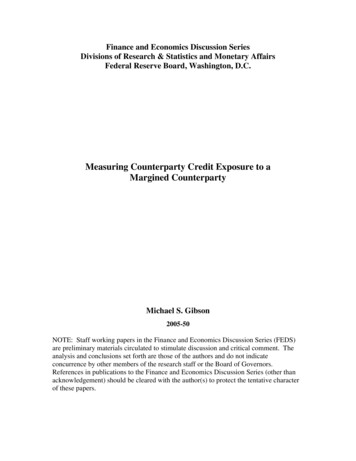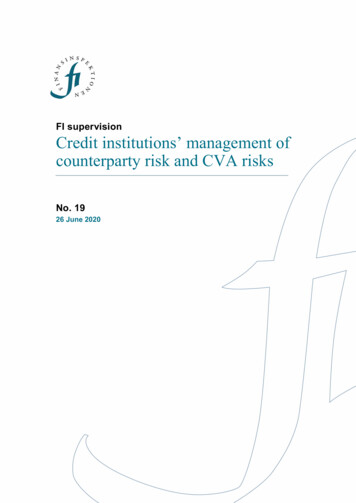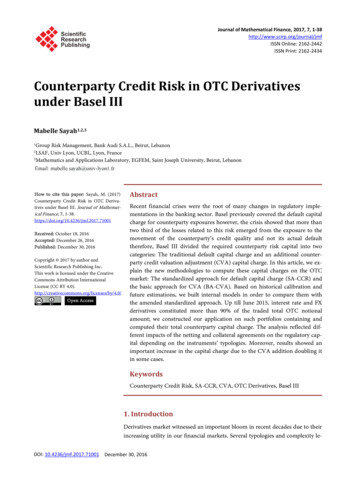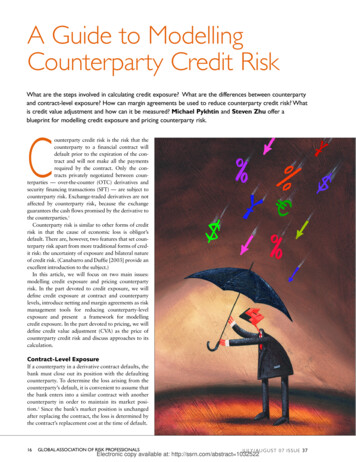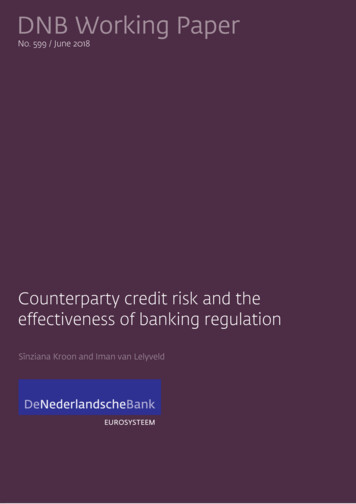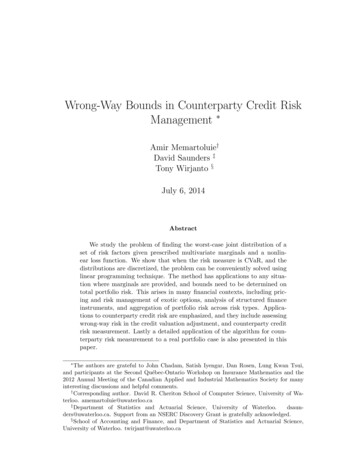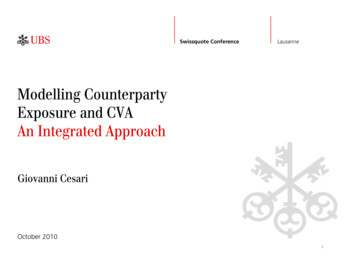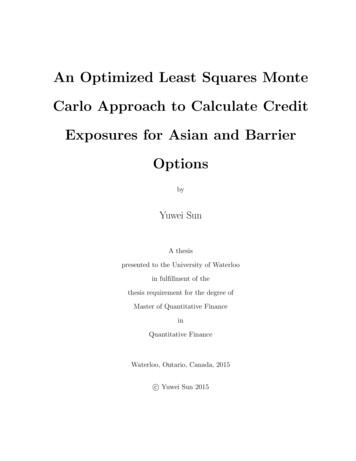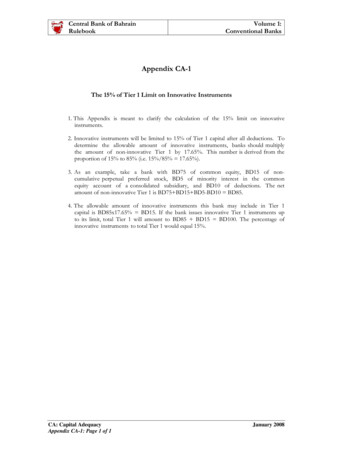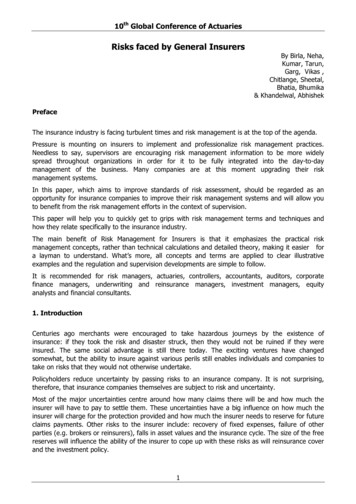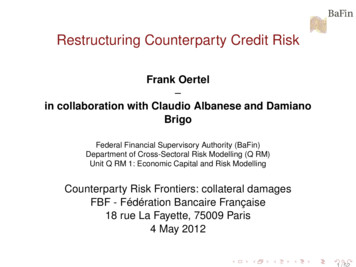
Transcription
Restructuring Counterparty Credit RiskFrank Oertel–in collaboration with Claudio Albanese and DamianoBrigoFederal Financial Supervisory Authority (BaFin)Department of Cross-Sectoral Risk Modelling (Q RM)Unit Q RM 1: Economic Capital and Risk ModellingCounterparty Risk Frontiers: collateral damagesFBF - Fédération Bancaire Française18 rue La Fayette, 75009 Paris4 May 2012
DisclaimerThis presentation and associated materials are provided forinformational and educational purposes only. Views expressedin this work are the authors’ views. They are not necessarilyshared by the Federal Financial Supervisory Authority.
DisclaimerThis presentation and associated materials are provided forinformational and educational purposes only. Views expressedin this work are the authors’ views. They are not necessarilyshared by the Federal Financial Supervisory Authority.In particular, our research is by no means linked to any presentand future wording regarding global regulation of CCRincluding EMIR and CRR.
DisclaimerThis presentation and associated materials are provided forinformational and educational purposes only. Views expressedin this work are the authors’ views. They are not necessarilyshared by the Federal Financial Supervisory Authority.In particular, our research is by no means linked to any presentand future wording regarding global regulation of CCRincluding EMIR and CRR.This is work in progress. In particular, definitions, abbreviationsand symbolic language in this work can be subject of change(ambiguity of terms in the literature).
A very few references I[1] C. Albanese, D. Brigo and F. Oertel.Restructuring counterparty credit risk.Bundesbank Discussion Paper, Series 2 - submitted.[2] S. Assefa, T. Bielecki, S. Crépey and M. Jeanblanc.CVA computation for counterparty risk assessment in creditportfolios.Credit Risk Frontiers. Editors T. Bielecki, D. Brigo and F.Patras, John Wiley & Sons (2011).[3] T. F. Bollier and E. H. Sorensen.Pricing swap default risk.Financial Analysts Journal Vol. 50, No. 3, pp. 23-33 (1994).[4] D. Brigo and A. Capponi.Bilateral counterparty risk valuation with stochasticdynamical models and application to credit default swaps.Working Paper, Fitch Solutions and CalTech (2009).
A very few references II[5] J. Gregory.Counterparty Credit Risk.John Wiley & Sons Ltd (2010).[6] J. Hull and A. White.CVA and Wrong Way Risk.Working Paper, Joseph L. Rotman School of Management,University of Toronto (2011).[7] M. Pykhtin.A Guide to Modelling Counterparty Credit Risk.GARP Risk Review, 37, 16-22 (2007).[8] H. Schmidt.Basel III und CVA aus regulatorischer Sicht.Kontrahentenrisiko. S. Ludwig, M. R. W. Martin und C. S.Wehn (Hrsg.), Schäfer-Pöschel (2012).
Contents1 An axiomatic approach to the pricing of CCR2 Close-out according to ISDA3 First-to-Default Credit Valuation Adjustment (FTDCVA)4 UCVA and Basel III5 Margin Lending
1 An axiomatic approach to the pricing of CCR2 Close-out according to ISDA3 First-to-Default Credit Valuation Adjustment (FTDCVA)4 UCVA and Basel III5 Margin Lending
FrameworkConsider the following two trading parties: party 0 and party 2.Let T 0 be the final maturity of this trade.
FrameworkConsider the following two trading parties: party 0 and party 2.Let T 0 be the final maturity of this trade. In this talk will adapt a “network view”.
FrameworkConsider the following two trading parties: party 0 and party 2.Let T 0 be the final maturity of this trade. In this talk will adapt a “network view”. Let k {0, 2} be given and let X (X(t))0 t T denote astochastic process describing a (possibly vulnerable) cashflow between party 0 and party 2 (or a random sequence ofprices). If, at time t, Xt is seen from the point of view ofparty k, we denote its value equivalently as Xt (k) orXt (k; 2 k) or Xk (t) - depending on its eligibility.
FrameworkConsider the following two trading parties: party 0 and party 2.Let T 0 be the final maturity of this trade. In this talk will adapt a “network view”. Let k {0, 2} be given and let X (X(t))0 t T denote astochastic process describing a (possibly vulnerable) cashflow between party 0 and party 2 (or a random sequence ofprices). If, at time t, Xt is seen from the point of view ofparty k, we denote its value equivalently as Xt (k) orXt (k; 2 k) or Xk (t) - depending on its eligibility. Moreover, we will make use of the important notationYt (k 2 k) to describe a cash flow Y from the point of viewof party k at time t contingent on the default of party 2 k.
FrameworkConsider the following two trading parties: party 0 and party 2.Let T 0 be the final maturity of this trade. In this talk will adapt a “network view”. Let k {0, 2} be given and let X (X(t))0 t T denote astochastic process describing a (possibly vulnerable) cashflow between party 0 and party 2 (or a random sequence ofprices). If, at time t, Xt is seen from the point of view ofparty k, we denote its value equivalently as Xt (k) orXt (k; 2 k) or Xk (t) - depending on its eligibility. Moreover, we will make use of the important notationYt (k 2 k) to describe a cash flow Y from the point of viewof party k at time t contingent on the default of party 2 k. Notice that the permutation s : {0, 2} {0, 2}, k 7 2 kis bijective. It satisfies s s s. (Or put s(k) : 3 k if sshould permute the numbers 1 and 2 instead.)
The set of all bilateral CCR scenariosLet k {0, 2}. Let τk denote the random default time of party kand T 0 be the final maturity of the payoff of the tradedportfolio of derivatives. Consider the following sets:
The set of all bilateral CCR scenariosLet k {0, 2}. Let τk denote the random default time of party kand T 0 be the final maturity of the payoff of the tradedportfolio of derivatives. Consider the following sets: N : {τ0 T and τ2 T} (i. e., both, party 0 and party 2 donot default until T);
The set of all bilateral CCR scenariosLet k {0, 2}. Let τk denote the random default time of party kand T 0 be the final maturity of the payoff of the tradedportfolio of derivatives. Consider the following sets: N : {τ0 T and τ2 T} (i. e., both, party 0 and party 2 donot default until T); A k : {τk T and τk τ2 k } (i. e., party k defaults first anduntil T);
The set of all bilateral CCR scenariosLet k {0, 2}. Let τk denote the random default time of party kand T 0 be the final maturity of the payoff of the tradedportfolio of derivatives. Consider the following sets: N : {τ0 T and τ2 T} (i. e., both, party 0 and party 2 donot default until T); A k : {τk T and τk τ2 k } (i. e., party k defaults first anduntil T); Ak : {τk T and τk τ2 k } A2 k (i. e., party 0 andparty 2 default simultaneously - until T).
The set of all bilateral CCR scenariosLet k {0, 2}. Let τk denote the random default time of party kand T 0 be the final maturity of the payoff of the tradedportfolio of derivatives. Consider the following sets: N : {τ0 T and τ2 T} (i. e., both, party 0 and party 2 donot default until T); A k : {τk T and τk τ2 k } (i. e., party k defaults first anduntil T); Ak : {τk T and τk τ2 k } A2 k (i. e., party 0 andparty 2 default simultaneously - until T).
The set of all bilateral CCR scenariosLet k {0, 2}. Let τk denote the random default time of party kand T 0 be the final maturity of the payoff of the tradedportfolio of derivatives. Consider the following sets: N : {τ0 T and τ2 T} (i. e., both, party 0 and party 2 donot default until T); A k : {τk T and τk τ2 k } (i. e., party k defaults first anduntil T); Ak : {τk T and τk τ2 k } A2 k (i. e., party 0 andparty 2 default simultaneously - until T).Observation· ·Ω N · A 0 A2 A0 .
The set of all bilateral CCR scenariosLet k {0, 2}. Let τk denote the random default time of party kand T 0 be the final maturity of the payoff of the tradedportfolio of derivatives. Consider the following sets: N : {τ0 T and τ2 T} (i. e., both, party 0 and party 2 donot default until T); A k : {τk T and τk τ2 k } (i. e., party k defaults first anduntil T); Ak : {τk T and τk τ2 k } A2 k (i. e., party 0 andparty 2 default simultaneously - until T).Observation· ·Ω N · A 0 A2 A0 .In the following we assume that Q(A0 ) 1 (where Qdenotes a “risk neutral measure” . . .).
DefinitionLet X (Xt )t [0,T] be an arbitrary stochastic process. X is callednon-vulnerable if X and 11N X almost surely have the samesample paths, else X is called vulnerable.
Money Conservation Principle (MCP)Definition (Money Conservation Principle)Let x be an arbitrary amount of money (which could be anegative number), measured in a single fixed currency unit U(e.g., U : e). Let k {0, 2}. TFAE: Party k receives x currency units U from party 2 k; Party 2 k pays x currency units U to party k; Party 2 k receives x currency units U from party k.Thus, paying x currency units U is by definition equivalent toreceiving x currency units U for all real money values x,implying that any non-vulnerable cash flow X (Xt )0 t Tbetween party k and its counterpart 2 k satisfiesXt (k) Xt (2 k) for all 0 t T. Hence, an asset for party krepresents a liability for party 2 k.
Valuation of defaultable claims IDefaultable claims can be valued by interpreting them asportfolios of claims between non-defaultable counterpartiesincluding the riskless claim and mutual default protectioncontracts. From the point of view of party k latter says:Fix k {0, 2}. Party k sells to party 2 k default protection onparty 2 k contingent to an amount specified by a close-outrule.
Valuation of defaultable claims IDefaultable claims can be valued by interpreting them asportfolios of claims between non-defaultable counterpartiesincluding the riskless claim and mutual default protectioncontracts. From the point of view of party k latter says:Fix k {0, 2}. Party k sells to party 2 k default protection onparty 2 k contingent to an amount specified by a close-outrule.Let 0 t τ0 τ2 T and let Mt (k) be the mark-to-market value to party k in case both,party k and party 2 k are default-free; CVAt (k 2 k) be the value of default protection that party ksells to party 2 k contingent on the default of party 2 k.
Valuation of defaultable Claims IIAt t party k requires a payment of the “CCR risk premium”CVAt (k 2 k) 0 from party 2 k to be compensated for therisk of a default of party 2 k.
Valuation of defaultable Claims IIAt t party k requires a payment of the “CCR risk premium”CVAt (k 2 k) 0 from party 2 k to be compensated for therisk of a default of party 2 k. Conversely, party 2 k requires apayment of CVAt (2 k k) 0 from party k to be compensatedfor the risk of a default of party k. Therefore, party 2 k reportsat t the “bilaterally CCR-adjusted” value (defined as “fair value”in FAS 157):Vt (2 k) : CVAt (2 k k) Mt (2 k) CVAt (k 2 k)
Valuation of defaultable Claims IIAt t party k requires a payment of the “CCR risk premium”CVAt (k 2 k) 0 from party 2 k to be compensated for therisk of a default of party 2 k. Conversely, party 2 k requires apayment of CVAt (2 k k) 0 from party k to be compensatedfor the risk of a default of party k. Therefore, party 2 k reportsat t the “bilaterally CCR-adjusted” value (defined as “fair value”in FAS 157):Vt (2 k) : CVAt (2 k k) Mt (2 k) CVAt (k 2 k)The inclusion of DVA began 2005. In September 2006 theaccounting standard in relation to fair value measurements FAS157 (The Statements of Financial Accounting Standard, No157 ) asked banks to record a DVA entry (implying that the DVAof one party is the CVA of the other).
Valuation of defaultable Claims IIIFAS 157 namely says: “. Because nonperformance riskincludes the reporting entity’s credit risk, the reporting entityshould consider the effect of its credit risk (credit standing) onthe fair value of the liability in all periods in which the liability ismeasured at fair value under other accountingpronouncements.”
Valuation of defaultable Claims IIIFAS 157 namely says: “. Because nonperformance riskincludes the reporting entity’s credit risk, the reporting entityshould consider the effect of its credit risk (credit standing) onthe fair value of the liability in all periods in which the liability ismeasured at fair value under other accountingpronouncements.”The European equivalent of FAS 157 is the fair value provisionof IAS 39 which had been published by the InternationalAccountancy Standards Board in 2005, showing similarwording with respect to the valuation of CCR.So, we defineDVAt (k) : DVAt (k; 2 k) : CVAt (2 k k) .(1)
Valuation of defaultable Claims IVConsequently,Vt (2 k) CVAt (2 k k) Mt (2 k) CVAt (k 2 k)
Valuation of defaultable Claims IVConsequently,Vt (2 k) CVAt (2 k k) Mt (2 k) CVAt (k 2 k) Mt (2 k) DVAt (2 k; k) CVAt (2 k k)
Valuation of defaultable Claims IVConsequently,Vt (2 k) CVAt (2 k k) Mt (2 k) CVAt (k 2 k) Mt (2 k) DVAt (2 k; k) CVAt (2 k k) Mt (2 k) BVAt (2 k; k) ,(2)whereXBVAt (2 k; k) : CVAt (2 k k) DVAt (2 k; k) BVAt (k; 2 k) .
Valuation of defaultable Claims IVConsequently,Vt (2 k) CVAt (2 k k) Mt (2 k) CVAt (k 2 k) Mt (2 k) DVAt (2 k; k) CVAt (2 k k) Mt (2 k) BVAt (2 k; k) ,(2)whereXBVAt (2 k; k) : CVAt (2 k k) DVAt (2 k; k) BVAt (k; 2 k) .Similarly (due to the MCP and permutation):(2)(!)Vt (k) Mt (k) BVAt (k; 2 k) Vt (2 k)(3)for all 0 t τ0 τ2 T. Hence, both parties agree. Morerisky parties pay less risky parties in order to trade with them.
Valuation of defaultable Claims VActually we have seen more: namely the following fact whichcompletely ignores the construction/definition of DVA:ObservationAssume that the MCP holds, and suppose that both partiesinclude a possible future default of their respective counterpart.Then Vt (k) : Mt (k) CVAt (k 2 k) CVAt (2 k k) Vt (2 k)for all k {0, 2} and 0 t τ0 τ2 T, implying that the MCPcan be transferred to the vulnerable cash flow V.
Implications of the traditional CVA/DVAmechanics ILet us assume that party k is default-free (such as e. g. theFrench National Bank (hopefully.)). ThenCVAt (2 k k) DVAt (k; 2 k) 0 for all 0 t τ2 k T. Ifhowever, party 2 k converges to its own default,CVAt (k 2 k) . . . if t τ2 k . Consequently,Vt (k) Mt (k) CVAt (k 2 k) . . . if t τ2 k ,implying that the default-free party k would be strongly exposedto an increase of CVAt (k 2 k) - transferred from the riskyparty 2 k to the solvent party k.
Implications of the traditional CVA/DVAmechanics ILet us assume that party k is default-free (such as e. g. theFrench National Bank (hopefully.)). ThenCVAt (2 k k) DVAt (k; 2 k) 0 for all 0 t τ2 k T. Ifhowever, party 2 k converges to its own default,CVAt (k 2 k) . . . if t τ2 k . Consequently,Vt (k) Mt (k) CVAt (k 2 k) . . . if t τ2 k ,implying that the default-free party k would be strongly exposedto an increase of CVAt (k 2 k) - transferred from the riskyparty 2 k to the solvent party k.And what does the risky party report?
Implications of the traditional CVA/DVAmechanics ILet us assume that party k is default-free (such as e. g. theFrench National Bank (hopefully.)). ThenCVAt (2 k k) DVAt (k; 2 k) 0 for all 0 t τ2 k T. Ifhowever, party 2 k converges to its own default,CVAt (k 2 k) . . . if t τ2 k . Consequently,Vt (k) Mt (k) CVAt (k 2 k) . . . if t τ2 k ,implying that the default-free party k would be strongly exposedto an increase of CVAt (k 2 k) - transferred from the riskyparty 2 k to the solvent party k.And what does the risky party report?Vt (2 k) Vt (k) Mt (2 k) DVAt (2 k; k) . . . if t τ2 k !
Implications of the traditional CVA/DVAmechanics IISaying it in other words again:Whenever an entity’s credit worsens, it receives a subsidy fromits counterparties in the form of a DVA positive mark to marketwhich can be monetised by the entity’s bond holders only attheir own default. Whenever an entity’s credit improves instead,it is effectively taxed as its DVA depreciates.Wealth is thus transferred from the equity holders of successfulcompanies to the bond holders of failing ones, the transferbeing mediated by banks acting as financial intermediaries andimplementing the traditional CVA/DVA mechanics.
The role of partial informationFix 0 t u T. Let Ft denote the information of a specificinvestor at t, representing all observable market quantities butthe default events or any factors that might be linked to creditratings of the both parties, and let Gt represent the investor’senlarged information at time t, consisting of knowledge of thebehaviour of market prices up to time t as well as (possible)default times until t. With respect to the information Ft defaultsuntil t would arrive suddenly, as opposed to the case of theenlarged information Gt .
Representation of the MtM M - FTAP IFix k {0, 2} and let 0 t T. Consider the random variable(t,T]Πk 1Z: D(0, t)TD(0, u)dΦk (u) ,twhere Φk (viewed from party k) denotes a non-vulnerablecumulative dividend process of the portfolio over the timehorizon [0, T] and D(0, ·) a continuous F-adapted discountfactor process (which both are assumed to be of finitevariation).
Representation of the MtM M - FTAP IFix k {0, 2} and let 0 t T. Consider the random variable(t,T]Πk 1Z: D(0, t)TD(0, u)dΦk (u) ,twhere Φk (viewed from party k) denotes a non-vulnerablecumulative dividend process of the portfolio over the timehorizon [0, T] and D(0, ·) a continuous F-adapted discountfactor process (which both are assumed to be of finite(t,T]variation). Πk represents the sum of all future cash flows ofthe portfolio between t and T not accounting for CCR (seenfrom the point of view of party k) discounted to t. Notice thatΦk Φ2 k (due to the MCP).
Representation of the MtM M - FTAP IFix k {0, 2} and let 0 t T. Consider the random variable(t,T]Πk 1Z: D(0, t)TD(0, u)dΦk (u) ,twhere Φk (viewed from party k) denotes a non-vulnerablecumulative dividend process of the portfolio over the timehorizon [0, T] and D(0, ·) a continuous F-adapted discountfactor process (which both are assumed to be of finite(t,T]variation). Πk represents the sum of all future cash flows ofthe portfolio between t and T not accounting for CCR (seenfrom the point of view of party k) discounted to t. Notice thatΦk Φ2 k (due to the MCP). Assume throughout that ourfinancial market model does not allow arbitrage and that eachCCR clean contingent claim between party k and party 2 k inthe portfolio (or netting set) is attainable therein.
Representation of the MtM M - FTAP IISeen from party k’s point of view the CCR clean mark-to-marketprocess Mk (Mk (t))0 t T (Mt (k))0 t T is then given byQMk (t) Eh(t,T]Πki ZQFt ET D(t, u)dΦk (u) Ft M2 k (t) ,twhere Q is a “risk-neutral measure” (due to the risk-neutralvaluation formula). In the following we fix Q and omit its extradescription in the notation of (conditional) expectationoperators.Another important piece of notation: For any stochastic processet : D(0, t)Xt and obtain the discounted process XeX we put Xwith numéraire D(0, ·).
The main bilateral CCR building blocks(t,u]Πk(t,u] Π2 kRandom CCR clean cumulative cashflows from the claim in (t, u], discountedto time t - seen from k’s point of view
The main bilateral CCR building blocks(t,u]Πk(t,u] Π2 k(t,T]Mk (t) EQ [Πk Ft ] M2 k (t)Random CCR clean cumulative cashflows from the claim in (t, u], discountedto time t - seen from k’s point of view(t,u]Random NPV (or MtM) of Πkgiven as conditional expectationw.r.t. a risk neutral measureQ, given the information Ft (cf. [2])
The main bilateral CCR building blocks(t,u]Πk(t,u] Π2 k(t,T]Mk (t) EQ [Πk Ft ] M2 k (t)0 Rk 1Random CCR clean cumulative cashflows from the claim in (t, u], discountedto time t - seen from k’s point of view(t,u]Random NPV (or MtM) of Πkgiven as conditional expectationw.r.t. a risk neutral measureQ, given the information Ft (cf. [2])k’s (rdm.) recovery rate; i. e., theportion of the payoff from the MtMpaid by party k to party 2 k incase of k’s default
The main bilateral CCR building blocks(t,u]Πk(t,u] Π2 k(t,T]Mk (t) EQ [Πk Ft ] M2 k (t)0 Rk 10 LGDk : 1 Rk 1D(t, u) : D(0, u)/D(0, t)Random CCR clean cumulative cashflows from the claim in (t, u], discountedto time t - seen from k’s point of view(t,u]Random NPV (or MtM) of Πkgiven as conditional expectationw.r.t. a risk neutral measureQ, given the information Ft (cf. [2])k’s (rdm.) recovery rate; i. e., theportion of the payoff from the MtMpaid by party k to party 2 k incase of k’s defaultk’s (random) Loss Given Defaultrandom discount factor at time t fortime u t
1 An axiomatic approach to the pricing of CCR2 Close-out according to ISDA3 First-to-Default Credit Valuation Adjustment (FTDCVA)4 UCVA and Basel III5 Margin Lending
CCR free close-out ISo, how is BVAt (k; 2 k) CVAt (k 2 k) DVAt (k; 2 k)actually determined? More precisely: what role do play ISDA’sclose-out rules here?
CCR free close-out ISo, how is BVAt (k; 2 k) CVAt (k 2 k) DVAt (k; 2 k)actually determined? More precisely: what role do play ISDA’sclose-out rules here?Throughout this presentation, the letter ω describes a random“event” and Ω the set of all possible random “events”. Weconsider functions of type 11A , where 11A (ω) : 1 if ω A and11A (ω) : 0 if ω / A. The whole analysis of CCR is based on the functions x : max{x, 0} and x : x x ( x) max{ x, 0}.
CCR free close-out ISo, how is BVAt (k; 2 k) CVAt (k 2 k) DVAt (k; 2 k)actually determined? More precisely: what role do play ISDA’sclose-out rules here?Throughout this presentation, the letter ω describes a random“event” and Ω the set of all possible random “events”. Weconsider functions of type 11A , where 11A (ω) : 1 if ω A and11A (ω) : 0 if ω / A. The whole analysis of CCR is based on the functions x : max{x, 0} and x : x x ( x) max{ x, 0}.Fix k {0, 2}, and assume that party 2 k defaults first; i. e.,A 2 k 6 . Suppose that the close-out is settled at τ2 k (nomargin period of risk) and that no collateral is exchangedbetween party k and party 2 k until τ2 k T.
CCR free close-out IILet ω A 2 k . A CCR free close-out (in a given netting set) isreflected in the following table:Party k receivesfrom party 2 kParty k pays toparty 2 kMk (τ2 k )(ω) 0R2 k (ω) · Mk (τ2 k )(ω)Mk (τ2 k )(ω) 000 Mk (τ2 k )(ω)Hence, for all k {0, 2} it follows that:11A Vk (τ2 k ) 11A 2 k2 kR2 k (Mk (τ2 k )) ( Mk (τ2 k )) 11A Mk (τ2 k ) 11A LGD2 k (Mk (τ2 k )) .2 k2 k
CCR free close-out IILet ω A 2 k . A CCR free close-out (in a given netting set) isreflected in the following table:Party k receivesfrom party 2 kParty k pays toparty 2 kMk (τ2 k )(ω) 0R2 k (ω) · Mk (τ2 k )(ω)Mk (τ2 k )(ω) 000 Mk (τ2 k )(ω)Hence, for all k {0, 2} it follows that:11A Vk (τ2 k ) 11A 2 k2 kR2 k (Mk (τ2 k )) ( Mk (τ2 k )) 11A Mk (τ2 k ) 11A LGD2 k (Mk (τ2 k )) .2 k2 kHowever, what about the inclusion of DVA?
ISDA’s replacement close-out rule Let ω A 2 k and put Mk (t) : Mk (t) DVAt (k; 2 k). Accordingto “ISDA’s replacement close-out rule” from 2009 (in a givennetting set) we derive the following table:Party k receivesfrom party 2 kParty k pays toparty 2 kMk (τ2 k )(ω) 0R2 k (ω) · Mk (τ2 k )(ω)Mk (τ2 k )(ω) 000 Mk (τ2 k )(ω)Hence, for all k {0, 2} it follows that:11A Vk (τ2 k ) 11A 2 k2 kR2 k (Mk (τ2 k )) ( Mk (τ2 k )) 11A Mk (τ2 k ) 11A LGD2 k (Mk (τ2 k )) .2 k2 k
Vulnerable cash flows ILet us revisit Brigo-Capponi’s construction of the followingvulnerable cash flow:b (t,T] : 11N · Π(t,T] 11 · Π(2 k) 11 · Π(k) ,ΠkkkkAA2 k(4)k(l)where the 2 2 random matrix (Πk )l,k {0,2} is given by(l)(t,τl ]Πk : Πk ( 1)for all l {k, 2 k}.k l2 e l (τl )) Me l (τl )D(0, t) 1 LGDl · (M
Vulnerable cash flows IIStudying carefully the proof of Brigo and Capponi one can seethat in fact (t,T] (!)bEQ Π Ft Mt (k)khie k (τ2 k )) Ft D(0, t) 1 EQ 11A LGD2 k (Mh 2 kie 2 k (τk )) Ft . D(0, t) 1 EQ 11A LGDk (Mk
1 An axiomatic approach to the pricing of CCR2 Close-out according to ISDA3 First-to-Default Credit Valuation Adjustment (FTDCVA)4 UCVA and Basel III5 Margin Lending
FTDCVA, FTDDVA and FTDBVA IPuthiFTDCVAt (k 2 k) : Et 11A LGD2 k D(t, τ2 k )(Mk (τ2 k )) ,2 kFTDDVAt (k; 2 k) : FTDCVAt (2 k k),FTDBVAk (t; T) : FTDCVAt (k 2 k) FTDDVAt (k; 2 k) .
FTDCVA, FTDDVA and FTDBVA IIDefinitionLet k 0 or k 2 and 0 t τ0 τ2 T (Q a.s.).(i) The positive Ft -measurable random variableFTDCVAt (k 2 k) is called First-to-Default CreditValuation Adjustment at t.(ii) The positive Ft -measurable random variableFTDDVAt (k; 2 k) : FTDCVAt (2 k k) is calledFirst-to-Default Debit Valuation Adjustment at t.(iii) The real Ft -measurable random variableFTDBVAt (k; 2 k) : FTDCVAt (k 2 k) FTDDVAt (k; 2 k)is called First-to-Default Bilateral Valuation Adjustment at t.
Brigo and Capponi revisitedTheorem (Brigo-Capponi (2008))Assume No-Arbitrage and that each CCR clean contingentclaim between party 0 and party 2 of a given portfolio isattainable. Let 0 t τ0 τ2 T (Q a.s.). Assume that theMCP holds. Let Mt (k) denote the mark-to-market value of theportfolio to party k in case both, 0 and 2 are default-free. If bothparties apply the CCR free close-out rule it follows that
Brigo and Capponi revisitedTheorem (Brigo-Capponi (2008))Assume No-Arbitrage and that each CCR clean contingentclaim between party 0 and party 2 of a given portfolio isattainable. Let 0 t τ0 τ2 T (Q a.s.). Assume that theMCP holds. Let Mt (k) denote the mark-to-market value of theportfolio to party k in case both, 0 and 2 are default-free. If bothparties apply the CCR free close-out rule it follows that (t,T] b Ft Mt (k) FTDBVAt (k; 2 k)EQ Πkfor all k {0, 2}.
UCVAt (k 2 k) as a special case ofFTDCVAt (k 2 k)Special Case (A single default onlyBasel III)Fix k {0, 2}. Assume that in addition τk (i. e., no default of party k). Then A 2 k {τ2 k T} and Ak . Consequently,FTDDVAt (k; 2 k) 0, (t,T] bEQ Π Ft Mt (k) FTDCVAt (k 2 k) ,k
UCVAt (k 2 k) as a special case ofFTDCVAt (k 2 k)Special Case (A single default onlyBasel III)Fix k {0, 2}. Assume that in addition τk (i. e., no default of party k). Then A 2 k {τ2 k T} and Ak . Consequently,FTDDVAt (k; 2 k) 0, (t,T] bEQ Π Ft Mt (k) FTDCVAt (k 2 k) ,kand (t,T] bEQ Π2 k Ft Mt (2 k) FTDDVAt (2 k; k).
UCVAt (k 2 k) as a special case ofFTDCVAt (k 2 k)Special Case (A single default onlyBasel III)Fix k {0, 2}. Assume that in addition τk (i. e., no default of party k). Then A 2 k {τ2 k T} and Ak . Consequently,FTDDVAt (k; 2 k) 0, (t,T] bEQ Π Ft Mt (k) FTDCVAt (k 2 k) ,kand (t,T] bEQ Π2 k Ft Mt (2 k) FTDDVAt (2 k; k).Hence, if party k were the investor, and if τk theUnilateral CVA UCVAt (k, 2 k) : FTDCVAt (k 2 k) wouldhave to be paid by party 2 k to the default free party k at t tocover a potential default of party 2 k after t.
Structure of FTDCVAt (k 2 k)Although we write “FTDCVAt (k 2 k)” it always should be keptin mind that we actually are working with a very complex object,namely:FTDCVAk (t, T, LGD2 k , τk , τ2 k , D(t, τ2 k ), Mk (τ2 k )) !
1 An axiomatic approach to the pricing of CCR2 Close-out according to ISDA3 First-to-Default Credit Valuation Adjustment (FTDCVA)4 UCVA and Basel III5 Margin Lending
UCVA and Basel III - Part IFirstly we list a very restrictive case of a possible calculation ofUCVA, encoded in the much too simple “CVA PD LGD EE”formula which however seems to be used often in financialinstitutes.Proposition (Rough Approximation – Part I)Let k {0, 2}. Assume that(i) party k will not default until T: τk : ;(ii) LGD2 k is constant and non-random;e k (τ2 k )) and τ2 k are independent under Q (i. e., WWR(iii) (Mor RWR is ignored completely).Then e k (τ2 k )) .UCVA0 (k 2 k) Q(τ2 k T) · LGD2 k · EQ (M
UCVA and Basel III - Part IISuppose there exists a further random variable M (a “marketrisk factor”) so that Mk (τ2 k ) is a function of M as well,Mk (τ2 k , M) say.Proposition (Rough Approximation – Part II)Assume that(i) Party k will not default until T: τk : ;(ii) LGD2 k is constant and non-random;(iii) For all t D(0, t) does not depend on M;(iv) M and τ2 k are independent under Q.ThenZUCVAk (0 T) LGD2 k0TD(0, t)EQ [(Mk (t, M)) ] dFτQ2 k (t),where FτQ2 k (t) : Q(τ2 k t) for all t R (unconditional df).
Proof.Put Φ(t, m) : 11[0,T] (t) · ψ(t, m), where (t, m) R R andQdenote the bivariateψ(t, m) : D(0, t) · (Mk (t, m)) . Let F(τ2 k ,M)df of the random vector (τ2 k , M) w.r.t. Q. ThenUCVA0 (k 2 k)(i),(ii) (iv),Fubini (iii) LGD2 k EQ [Φ(τ2 k , M)]ZQ(t, m)Φ(t, m)dF(τLGD2 k2 k ,M)R RZ Z QLGD2 kψ(t, m)dFM(m) dFτQ2 k (t)[0,T]TZLGD2 k0RD(0, t)EQ [(Mk (t, M)) ]dFτQ2 k (t).
Wrong-Way Risk and Right-Way Risk I(M)EEk (t) : EQ [(Mk (t, M)) ] is known as party k’s ExpectedExposure at t. In general it can be identified by MC simulationonly.
Wrong-Way Risk and Right-Way Risk I(M)EEk (t) : EQ [(Mk (t, M)) ] is known as party k’s ExpectedExpos
A Guide to Modelling Counterparty Credit Risk. GARP Risk Review, 37, 16-22 (2007). . 3 First-to-Default Credit Valuation Adjustment (FTDCVA) 4 UCVA and Basel III 5 Margin Lending 5/52. 1 An axiomatic approach to the pricing of CCR 2 Close-out according to ISDA 3 First-to-Default Credit Valuation Adjustment (FTDCVA . we denote its value .
